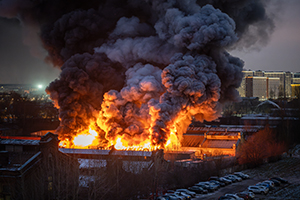C.G.S. § 53a-111 — Arson in the First Degree
 A person commits Arson in the First Degree when, with intent to destroy or damage a building, they start a fire or cause an explosion, and any one of the following is true:
A person commits Arson in the First Degree when, with intent to destroy or damage a building, they start a fire or cause an explosion, and any one of the following is true:
- The building is inhabited or occupied, or the person has reason to believe someone may be inside;
- Another person is injured as a result;
- The fire or explosion is set to collect insurance proceeds; or
- A peace officer or firefighter, in the performance of official duties at the scene, is subjected to a substantial risk of bodily injury.
“Building” is defined broadly and can include structures or vehicles used for lodging or business.
Elements the State Must Prove- Intent to destroy or damage a building;
- An act of starting a fire or causing an explosion;
- At least one qualifying circumstance (occupied/inhabited, injury, insurance motive, or substantial risk to first responders).
- Class A felony
- Imprisonment: 10 to 25 years
- Fine: up to $20,000
- Probation: possible at the court’s discretion, with strict conditions (e.g., no-contact, restitution)
- Overnight blaze in a multi-family house with tenants home.
- After-hours fire in a shop where recent insurance changes suggest a financial motive.
- Warehouse fire that forces firefighters into flashover/collapse conditions.
- Fire spreading from a targeted area that causes smoke inhalation injuries to neighbors or responders.
- Insurance-motivated storefront fire: A shop owner falls behind on rent, boosts coverage weeks before a late-night fire starts in a back room where accelerant patterns are later documented. No one is inside, but the insurance-proceeds motive is enough to satisfy the statute when coupled with intent and origin evidence.
- Hallway fire in an occupied triple-decker: After a dispute, someone ignites clothing in a first-floor corridor of a three-family house. Even if damage is contained, the building is inhabited and the act was intentional, meeting the statute’s occupied-building prong.
- Risk to firefighters at a storage facility: A deliberately set blaze in a storage complex produces heavy smoke and structural instability. Responding firefighters performing their duties face a substantial risk of injury while searching the structure, satisfying the first-responder risk prong.
- Electrical fault, no intent to damage: A café burns after closing. Independent origin-and-cause work shows the fire began at a faulty junction box in the ceiling. With no human-set ignition and no intent to damage a building, the elements of § 53a-111 are not met; the appropriate outcome is dismissal or reduction to a non-intent offense.
- § 53a-112 — Arson in the Second Degree (Class B)
- § 53a-113 — Arson in the Third Degree (Class C)
- § 53a-114 — Reckless Burning (Class D)
- § 53a-115 to § 53a-117 — Criminal Mischief (damage without arson elements)
- § 53-21 — Risk of Injury to a Minor (when children are endangered)
- § 53a-63 — Reckless Endangerment (endangering others without meeting arson elements)
- § 53a-215 — Insurance Fraud (often paired with alleged for-profit fires)
Element challenges
- Intent to damage a building: Emphasize accident, electrical/appliance failure, spontaneous combustion, or other non-intent causes.
- Origin & cause science: Use independent fire experts to test accelerant claims, burn pattern interpretations, timing, and point-of-origin methodology.
- Building/occupancy proof: Scrutinize whether the location meets the statutory “building” definition and whether occupation/presence was proven or reasonably believed.
- Injury and responder-risk proof: Verify causation, extent of injuries, and whether the responder risk was substantial based on reports and tactical timelines.
- Insurance-motive rebuttal: Counter with financials, policy timing, and alternative reasons for coverage changes.
Procedural tools
- Suppression of unlawful searches or statements; challenge scene re-entries and warrant scope.
- Discovery demands for full origin-and-cause files, lab results, and responder videos.
Charge-level pathways
- When intent or qualifying factors are weak, pursue reductions to § 53a-112, § 53a-113, or § 53a-114, or negotiate resolutions that address restitution and safety concerns without a Class A conviction.
Diversionary programs
- Accelerated Rehabilitation (AR): Not available for Class A felonies like § 53a-111.
A § 53a-111 charge is high-stakes. We move immediately to secure scene photos, videos, reports, and independent fire-science review, then pressure-test the statute’s intent and qualifying prongs.
Call (203) 357-5555 or use our online contact form for a confidential consultation. We defend arson cases statewide and fight to protect your record, your rights, and your future.
 Allan F. Friedman Criminal Lawyer Home
Allan F. Friedman Criminal Lawyer Home















